The Port of Santa Cruz de La Palma is located on the eastern coast of La Palma, one of Spain's Canary Islands. The island is renowned for its dramatic volcanic landscapes, lush forests, and clear skies, earning it the nickname 'La Isla Bonita' (The Beautiful Island). The port is a vital connection for the island, handling passenger ferries, cargo, and a growing number of cruise ships.
As a cruise destination, it is a popular stop on Canary Islands and transatlantic repositioning itineraries. The modern port offers a stunning arrival experience, with ships docking directly beneath the volcanic hillsides and right next to the charming, well-preserved historic capital city, Santa Cruz de La Palma. Its convenient location allows for immediate immersion into the local culture and scenery.
The main attraction is the Caldera de Taburiente National Park, a massive erosion crater that forms the heart of the island. While deep exploration requires time, visitors can drive to viewpoints like La Cumbrecita (about 45 minutes from the port) for breathtaking views into the caldera. Ship-sponsored excursions are often the best way to experience the park on a tight schedule.
For incredible panoramic views, a trip to the Roque de los Muchachos Observatory is unparalleled. Perched at the island's highest point, it's one of the world's premier astronomical sites. The drive is long and winding (approx. 1.5 hours each way), so this is typically only feasible as a full-day shore excursion.
A more accessible volcanic experience can be found at the Volcán de San Antonio in the south. A visitor center provides insight into the island's geology, and you can walk along the crater rim for stunning views. This is about a 40-minute drive from Santa Cruz.
The historic center of Santa Cruz de La Palma itself is a primary attraction. Just steps from the port, you can admire the famous wooden balconies along Avenida Marítima, explore the Renaissance architecture of Plaza de España, and wander the charming cobblestone streets.
Last updated on June 26, 2025
A popular destination is the town of Los Llanos de Aridane, the island's largest municipality, located on the sunnier west side. The journey takes about 40 minutes by car or bus and offers a different, more modern atmosphere compared to the capital. The town serves as a great base for exploring the west coast.
In the south of the island, about a 45-minute drive from the port, lies the municipality of Fuencaliente. This area is famous for its volcanic landscapes, including the Teneguía volcano which last erupted in 1971, and the fascinating Salinas de Fuencaliente salt pans. The drive itself offers dramatic coastal views.
For nature lovers, the lush laurel forests of Los Tilos, a UNESCO Biosphere Reserve, are a must-see. Located in the northeast about 30-40 minutes from Santa Cruz, this area offers accessible trails through a prehistoric-feeling forest.
Last updated on June 26, 2025
The cruise port of Santa Cruz de La Palma is ideally situated directly adjacent to the city's historic center. Passengers can walk from the ship's gangway to the main streets, shops, and attractions of the capital in just 5 to 10 minutes. The picturesque Avenida Marítima, with its famous traditional balconies, is immediately accessible.
No shuttles are necessary to explore Santa Cruz de La Palma. Ships dock directly at the Muelle de Cruceros, so tendering is not required. The cruise terminal itself has basic facilities, including restrooms and tourist information, while a wide variety of cafes, restaurants, and shops are located just a short stroll away in the city.
Last updated on June 26, 2025
The official currency in La Palma is the Euro (€). While some tourist-oriented shops might accept US dollars, it is not common, and the exchange rate will be unfavorable. It is highly recommended to use Euros for all transactions.
ATMs, known locally as 'cajeros automáticos', are widely available throughout Santa Cruz de La Palma, including near the port area. Credit cards (Visa and Mastercard) are accepted in most hotels, restaurants, and larger stores, but it's wise to carry some cash for smaller purchases, market stalls, or bus fares.
Last updated on June 26, 2025
La Palma is generally considered a very safe destination with a low crime rate. It is safe for tourists to explore the main towns and attractions independently. Standard precautions, such as being aware of your surroundings and keeping valuables secure, are always wise but violent crime is extremely rare.
The primary safety concerns on the island are related to its natural environment. When hiking, stick to marked trails, wear appropriate footwear, and be prepared for sudden weather changes, especially at higher altitudes. Obey all warning signs near volcanic areas and be extremely cautious near the coast, as Atlantic currents can be powerful and dangerous. Do not swim at beaches that are not designated for swimming.
Last updated on June 26, 2025
La Palma enjoys a mild, subtropical climate year-round, often described as an 'eternal spring'. During the main cruise season from autumn through spring (October to May), temperatures are very pleasant. Daytime highs typically range from 20°C to 25°C (68°F to 77°F), with cooler evenings.
Rainfall is more common during these months but usually comes in short bursts, followed by sunshine. The island has various microclimates; the north and east are generally greener and more prone to clouds, while the south and west are sunnier and more arid. It is wise to pack in layers, including a light jacket or sweater for higher elevations or evenings, and a light waterproof layer. Sunscreen, sunglasses, and a hat are essential year-round as the sun is strong. The Canary Islands are not in the Atlantic hurricane belt.
Last updated on June 26, 2025
Santa Cruz de La Palma is very walkable, and its main attractions can be explored on foot from the cruise port. For destinations further afield, several options are available. Taxis are readily available at the port terminal and can be hired for direct trips or private island tours for a fixed price.
The island has an efficient and affordable public bus system, locally called 'guaguas'. The main bus station in Santa Cruz is a short walk from the port, offering routes to most major towns and attractions. You can find schedules and routes on the official Transportes Insular La Palma website. Ride-sharing services like Uber or Bolt are not currently available on the island.
Last updated on June 26, 2025
The best shopping in La Palma is concentrated in its capital, Santa Cruz. The main pedestrian shopping streets are Calle O'Daly and Calle Anselmo Pérez de Brito, which run parallel to the seafront. Here you will find a mix of local boutiques, well-known Spanish brands, and souvenir shops.
For local specialties, look for hand-rolled cigars ('puros'), which have a long tradition on the island. Other popular souvenirs include local honey, Malvasia wine, Mojo hot sauces, and artisan crafts like pottery and embroidery. The Mercado Municipal (city market) is a great place to find local food products.
Prices are generally fixed, and bargaining is not a common practice in stores. The Canary Islands have a special tax status, resulting in lower prices for goods like alcohol, tobacco, and cosmetics compared to mainland Europe.
Last updated on June 26, 2025
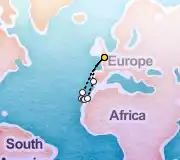
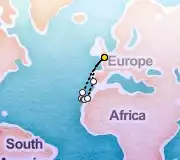
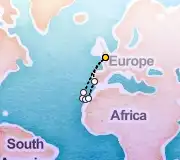

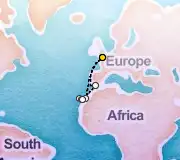
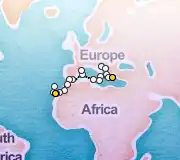
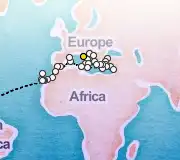
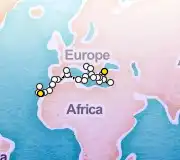
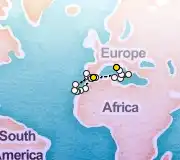
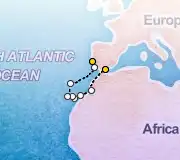

No ships scheduled in port today.
Sailings visiting La Palma during the peak seasons of winter and spring are much more expensive than the the low season of summer. On average cruises that visit La Palma are moderately expensive compared to other itineraries. Check the diagram below for the average cost per day by month.
Want to hear about the best deals and cruise tips every week? Sign up for our free weekly VIP Newsletter, customized exactly to your preferences!